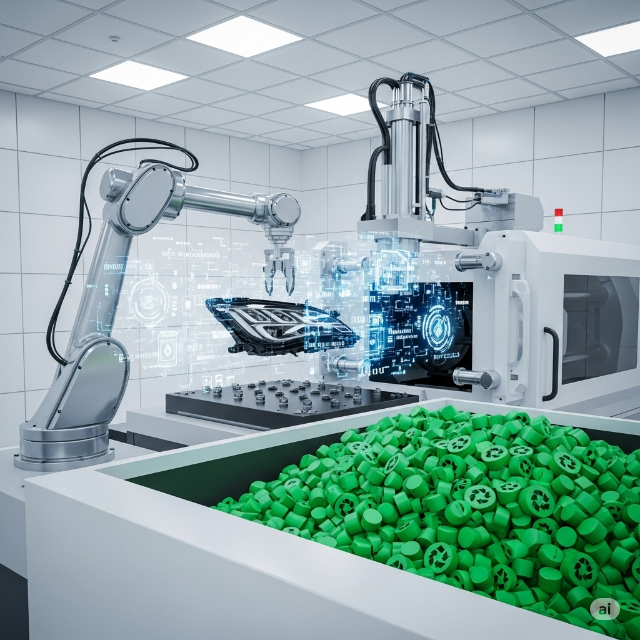How AI, Sustainability, and Advanced Materials Are Reshaping Injection Molding
2025-06-16

For years, the "smart factory" was a futuristic buzzword. In 2025, it is a tangible reality on the shop floor, delivering a decisive competitive advantage. The integration of digital technology is creating a new paradigm of efficiency and control.
At the heart of this shift is the Internet of Things (IoT). Sensors embedded within molds, machines, and auxiliary equipment now form a vast neural network, streaming real-time data on pressure, temperature, viscosity, and cycle times. This data is fed into Manufacturing Execution Systems (MES) and cloud platforms, giving managers an unprecedented, granular view of the entire production process.
This data-rich environment is the perfect breeding ground for Artificial Intelligence (AI) and machine learning. AI algorithms are now capable of self-optimizing machine parameters on the fly, compensating for minor variations in material batches or ambient humidity to ensure consistent part quality and minimize scrap rates. More impressively, predictive maintenance has become standard practice. By analyzing subtle changes in vibration, temperature, and power consumption, AI can forecast potential machine failures or tool wear weeks in advance, allowing maintenance to be scheduled during planned downtime and virtually eliminating costly, unexpected interruptions.
"We've moved from a reactive 'fix-it-when-it-breaks' model to a proactive, predictive one," explains Dr. Elena Vance, a manufacturing technology consultant. "This isn't just about preventing downtime. It's about optimizing every single cycle for peak performance and minimal energy use. AI is no longer an experiment; it's a core component of profitability."The Green Imperative: Sustainability as a Core Business StrategyDriven by regulatory pressure, consumer demand, and corporate responsibility, sustainability has evolved from a niche concern to a central pillar of the injection molding industry. The pursuit of a circular economy is now a primary driver of innovation.
The use of Post-Consumer Recycled (PCR) materials has surged, with advancements in sorting and compounding leading to higher-quality resins that are suitable for a wider range of applications, from packaging to automotive components. Alongside this, the development of bioplastics, such as Polylactic Acid (PLA) and Polyhydroxyalkanoates (PHA), continues to mature. While still facing challenges in cost and performance for high-end applications, they are making significant inroads in single-use products and packaging.
However, the biggest impact is seen in process efficiency. The market shift towards all-electric injection molding machines is accelerating, with companies reporting energy savings of up to 70% compared to older hydraulic systems. These machines also offer superior precision and cleaner operation, a critical advantage for medical and electronics molders.
Furthermore, mold technology itself is becoming greener. Conformal cooling—a technique, often enabled by 3D printing, that creates cooling channels that follow the shape of the part—is a game-changer. By providing faster and more uniform cooling, it can slash cycle times by 30-50%, directly reducing the energy consumed per part and boosting overall output.Pushing the Boundaries: Innovations in Materials and ProcessesThe third revolutionary force is the relentless pace of innovation in polymers and molding techniques, which are expanding the applications for plastic parts into previously unimaginable realms.
Metal replacement remains a key objective, especially in the automotive and aerospace sectors. High-performance composites—polymers reinforced with carbon or glass fibers—are now being molded into structural components that are as strong as aluminum but at a fraction of the weight. This "lightweighting" is critical for improving the range of electric vehicles and the fuel efficiency of aircraft.
At the other end of the scale, micro-molding is enabling radical miniaturization in the medical and electronics fields. This specialized process can create incredibly complex parts, such as gears for a drug-delivery device or connectors for a smartphone, that weigh less than a gram and have features measured in microns.
Simultaneously, Liquid Silicone Rubber (LSR) molding is experiencing a boom. Valued for its flexibility, durability, biocompatibility, and temperature resistance, LSR is the material of choice for next-generation medical seals, wearable technology, and automotive sensors. Advanced multi-shot molding techniques that combine LSR with rigid thermoplastics in a single process are opening doors to highly integrated and functional part designs.
In conclusion, the injection molding industry of 2025 is dynamic, intelligent, and increasingly sustainable. The convergence of AI-driven manufacturing, circular economy principles, and advanced material science is not just an incremental change but a fundamental revolution, paving the way for a more efficient and responsible era of manufacturing.




